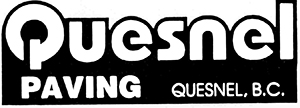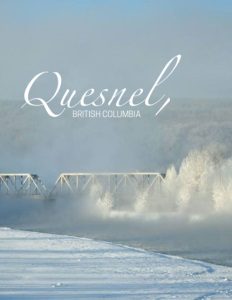Quesnel, British Columbia, a town of some 10,000, is located on the confluence of the Fraser and Quesnel Rivers, some 250 miles north-northeast of Vancouver. Originally settled by the Carrier First Nations, it was first named Quesnellemouthe, after Jules Maurice Quesnel, who accompanied Simon Fraser on his journey to the Pacific Ocean, and shortened to Quesnel in 1900. The town is also known as the “Gold Pan City,” a reference to its roots as the commercial center of the Cariboo Gold Rush in the 1860s. Quesnel even boasts that it is home to the world’s largest gold pan (a claim which some other gold mining towns and cities in the Pacific Northwest have challenged.)
While the glory days of gold extraction are long gone, for most of its existence, Quesnel has actually survived on another one of nature’s bountiful resources: timber. In fact, according to Mayor Bob Simpson, the lumber industry has historically been responsible for 70 percent or more of the town’s tax base. “In the province of British Columbia, I’d argue that our community is the most dependent on forestry,” he states.
But over the last several years, Quesnel’s ability to rely on exploiting that particular natural resource has been jeopardized, and Simpson says that unless the town was able to figure out a way to wean itself from wood and transform itself into a very different type of community, it would slowly die like many other primary-dependent communities have done in the past.
Simpson recounts that he intuited the town’s potential demise years ago when he first suspected that the allowable timber cut that the government establishes annually, and which it regards as sustainable, “would come crashing down at some point, because the forests would not be able to sustain the levels of harvesting that we were living off of.” Then, in 2002, a catastrophic, natural event precipitated an even quicker downfall of the town’s forestry industry.
“The Mountain Pine Beetle epidemic went on an exponential uptick,” he continues. “The community is dependent, almost solely, on the pine forest. We have fir and spruce around, as well, but in nominal amounts; we’re 80 percent pine-dependent. So, everybody who knew what they were looking at, knew that we were going to experience something fundamentally different than we have ever experienced before, with respect to the death of our pine forests. And as the forest sector goes, so can go the community. And if we’re not very deliberate, we can be in that boom and, ultimate, bust cycle that so many communities have experienced for centuries. So now,” he asks, “how do you take a community that has the potential to wind down because its core economy is going to be in trouble?”
The answer, according to the town’s leaders, was to reinvent the community in a way that allows it not merely to survive an onerous transition period, but to thrive through it and come out the other end as a transformed town with a new brand, a new way of doing municipal business, and a revitalized tax structure.
“And in order to do that, we spent the last couple of years getting fiscal sustainability,” says Simpson. “Up until 2015, this community was carrying a $2.4 million infrastructure deficit for roads, sewers, sidewalks, water systems, etc. And we had an operating budget that was sucking up all of the available cash. So, over the last two years, we’ve reduced our operating budget by ten percent. We took $1.2 million out of our budget, with some nominal service cuts, and nominal restructuring of our workforce, and then raised taxes significantly on our residents for two purposes: one, to be self-financing on our infrastructure. Lots of municipalities depend upon federal and provincial infrastructure dollars, which are hit and miss and at the whim and fancy of those senior levels of government. By 2018, we will be able to self-finance our infrastructure into the future.
“And then the other reason for raising residential taxes was to wean ourselves off of our dependence on industry. So by 2018-19, we’ll have reduced from a historic dependency of about 72 percent down to about 53 percent. At the end of the day, though, we will still be one of the lowest residential tax regimes in the province of British Columbia. And we will have raised residential taxes by 22-23 percent over four years.”
Simpson says that improving the town’s fiscal sustainability gave the populace a psychological lift. “Now that we believe we can sustain the community into the future, even if we lose a mill, we can adapt and adjust,” he avers. “So, our challenge going forward was: what do we need to do to build a truly sustainable, resilient community that will attract new residents, retain the ones that we have; attract investment and retain the businesses that we have; and attract visitors to drive our tourism economy, and, hopefully, turn some of those visitors into investors and residents?”
Simpson answers his own query by stating that many things needed to happen simultaneously. “You have to work on multiple fronts,” he explains. “The first challenge that we were immediately presented with was on the healthcare side. As we were trying to work on our fiscal sustainability, nine doctors in our community gave indication they were going to be leaving town. Based on our demographics, our health authority believes we should have about 32 doctors; we were operating with 23 and we were going to lose nine. So, rather than doing what other communities have done, which was go to the press, wring their hands, blame the province, blame recruiting, blame the health authority, etc., we mapped the system that was causing us to have problems recruiting and retaining doctors, and, with the health authority in a very proactive relationship, changed the whole model of primary care delivery in a rural community. Rather than going public, we worked behind the scenes to reconfigure the whole model.
“We unburdened the doctors for emergency coverage and hospital rounds; we addressed issues around anesthesiology and specialist needs; we addressed issues concerning salary positions versus setting up a private practice. As a result of that, and as a result of the city providing some incentives, the hospital district giving us money to have a full-time recruiter, and one of our local auto dealers giving us access to a vehicle for doctors, we recruited 15 doctors on the primary care side; we recruited more specialists, including a surgeon; we’ve reconstructed how we deliver emergency care; and we have a brand new primary care clinic that has state-of-the art telemedicine capacity, wound management, and various other things that unburdened our emergency services.
“From that, we learned that if you take a problem head-on, get the right partners in the room, you don’t have the story: ‘Quesnel has a mill closing and is losing doctors,’ you have a North American success story. And we’re going to take the same approach we took with primary care to mental health, addiction, and homelessness. Also, we have a very dramatically and rapidly aging population – we have one of the highest concentrations of seniors over 65 on a per capita basis, in the north. We would like to attract more 55-plus seniors, and retain more seniors between 65 and 70, so we’re going to map our seniors’ care delivery system with our seniors’ community so that we can deliver on a promise that this is a place you can retire to and spend your final years.”
Telling the story about Quesnel’s successes is part of the town’s brand re-invention, and one of the responsibilities of Amy Reid, Quesnel’s Economic Development Officer. “We go out once a year and talk to our business community” she says. “Last year, the number one thing we heard from businesses is that they wanted to see better marketing of our community. Our ‘Gold Pan City’ brand didn’t resonate to anybody. And although forestry will always be a part of who we are, it shouldn’t define us, either. We want to be described as a community that is sustainable, accessible, trail-blazing, and fun.” Thus, after much community input, it was decided that the town’s new brand tagline would be: Quesnel – It’s in Our Nature.
“How will we deliver on the brand promise?” Simpson asks, rhetorically. “If we say we’re sustainable, how will we be sustainable? If we say we’re accessible in the broader sense, how are we going to be accessible? How do we maintain affordability? How do we have one of the most accessible downtown cores; how do we have accessible, adaptable housing that seniors can age into? How are we going to be trailblazing? Where are we going to exercise the courage that’s required to be true trailblazers, and how are we going to exercise that fun piece? So, brand implementation and execution now becomes the goal.”
Quesnel is putting its rebranding exercise at the center of its official Community Plan, a manifesto required by the province that outlines a town’s priorities for the next decade or more. Simpson recounts that while working on the Plan, one of the town’s consultants reported, somewhat glibly, that Quesnel was being described by some as “a beautiful community you could drive through.” Simpson sees that as just another challenge to be understood, pondered, and, ultimately, met. “How do we become a community that people want to come to; that deliberately plans to make us a destination if they’re visitors, and deliberately make them desire to live and invest here?”
One item on the town’s agenda to get visitors to stop and linger is to reconfigure some downtown parking areas to accommodate the larger, recreational vehicles that tend to ply Highway 97 that runs through town. “In our downtown area, we have no capacity for RVs to stop,” Simpson laments. “So, they’re really forced to drive through.” Another plan is to open the city’s riverfront to recreation, commerce, and culture. “We’re a river city, yet we have no capacity to get people down to the rivers to have a meal, or park an RV, or whatever the case would be,” he continues. “And yet all that land that would be available is all city land – we own that property. So, how do we develop our riverfront property in a way that people would want to stop here?” One possible solution the town is working on partners it with one of its Aboriginal communities, the Lhtako Dene Nation, to see if, together, they can locate an Aboriginal cultural center at the confluence of the Fraser and Quesnel Rivers.
A second major initiative has the town working with the province to re-route, wherever possible, exits and intersections on Highway 97, the road that runs through the town from north to south and presents significant problems for pedestrian traffic. A third initiative that Simpson hopes will induce visitors to linger – and, perhaps some to settle – is a major renovation of Reid St., which also runs through downtown, parallel to, and a block east of, the Highway. “We have tagged Reid St. for complete redevelopment in 2018,” he says. “It’s going to be a three-million dollar investment. We’ll have an ideal opportunity to ask our community what it wants the downtown to look like as a ‘people precinct’ – as something that’s funky, interesting, fun, accessible, and trailblazing. So, I think in the next three to five years, we’ll be able to take the brand and drive it right into hard, infrastructure development of our downtown and get past ‘beautiful to drive through’ to become a place that people want to come to because we have so much to offer.”
Simpson says that Quesnel is also looking at adding to, or upgrading, its recreational amenities. “We have a plan to capitalize all our playgrounds, and we’re going to build two new playgrounds, this year. We’re looking at a new gymnastics facility; we’re looking at an addition to our pool and recreation center. We’re undertaking a trails initiative because we have a massive trails network around us that’s not mapped, not signed, not articulated, not well-marketing, and not really put together in a meaningful way.”
One method in which the town intends to promote its new brand, tell its new stories, and broadcast its new offerings, is via a totally revamped website. “Your web presence, how you present yourself in that domain, is how your visitors are finding you, how potential residents are finding you, and how potential investors are finding you,” Simpson says. So, we’re going to have a great, new interactive website in April.”
Once a gold rush town, then one that thrived on forestry, Quesnel is in the midst of re-inventing itself yet again. But its people are resilient, its leaders are committed to the future, and they all intend to see Quesnel continue to thrive by capitalizing on the town’s environmental and manmade assets. After all – it’s in their nature.
AT A GLANCE
WHO: Quesnel, British Columbia
WHAT: A city of 10,000
WHERE: The Cariboo district between Prince George and Williams
WEBSITE: www.quesnel.ca
PREFERRED VENDORS

Quesnel Paving – quesnelpaving@ycs.bc.ca
DIG DIGITAL?

March, 2017 Issue


